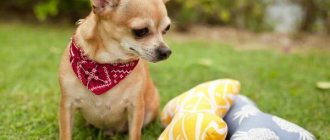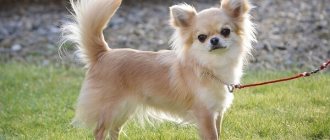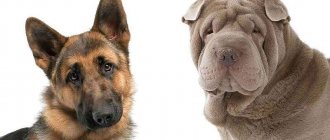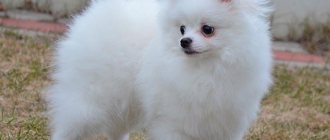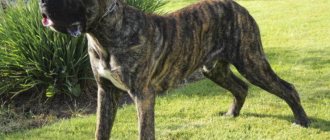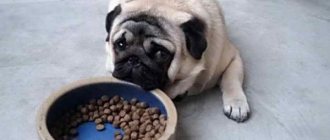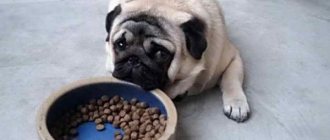The Cane Corso has an unusually interesting history: this breed was elevated to the pedestal of honor during the times of the patricians and practically disappeared after the change of power. And only the enthusiasm of Italian breeders helped save the unique descendants of the ancient Molossians.
But since there was not enough genetic material to quickly and completely recreate the breed in its original appearance, the blood of the Great Dane, Mastino Napoletano, Boxer and Staffordshire Terrier were infused into the breed . This made it possible to revive the Cane Corso in a short time (the photo will be published below), but gave its representatives some diversity.
Varieties and mixed breeds of the Rottweiler. Comparison with other dog breeds based on qualities
The Rottweiler is an intelligent, loyal, non-aggressive dog. She learns quickly, so she is used in the service of law enforcement agencies.
Breeders tried to get new animals by mating the Rottweiler with other dog breeds. This article will tell you in detail what types of mestizos exist and why they are unique.
Varieties
There are no species or subspecies. However, the popularity and widespread distribution of the breed around the world have added local flavor to national standards. Here is a list of the main varieties:
- German standard. This is a classic model Rottweiler.
- English standard. Based on Germanic. It has a calm character and excellent protective qualities.
- American standard. These are large dogs that are far from friendly in nature. Breeders were able to obtain the ideal animal for guard duty.
Further in the photo you can see representatives of this breed of dogs, including small Rottweilers.
Métis
Let's look at what kind of mixed breeds exist and see in the photo what a cross between a Rottweiler and a German Shepherd looks like, a mixture with a Labrador and other dog breeds.
German Shepherd mix
Malchover is a cross between a German and a Rottweiler. A muscular, calm, loyal, intelligent and self-confident dog has become a good friend to man. The weight of a large dog is 50 kg. He inherited the color from the Rottweiler, and the muzzle and ears from the German.
Metis has the following advantages:
- good intelligence;
- excellent watchdog qualities;
- easy to learn;
- devotion;
- Ability to remain calm in emergency situations.
With Labrador
The mixed breed is called a labra-rotweil. This complex canine artifact inherited good intelligence, conformation and temperament from its parents. Dogs are little known to people, because obtaining an ideal heir can be achieved after long and painstaking work.
With a pit bull
This mestizo was called a pit bull terrier. The dog is different:
- increased endurance;
- energy;
- fearlessness.
The color can be anything from solid black to black with brindle markings. The coat is smooth, short and shiny. The chest is wide and massive. The legs are of medium length and muscular.
The mixed breed is slightly smaller in size than a purebred Rottweiler. The weight of an adult is 30-40 kg.
Staffordshire Terrier
This is a cross between a Stafford and a Rottweiler. The dog has the following features:
- the dog is large in size and has well-developed muscles;
- endurance;
- calm character;
- loves to communicate with the owner and other dogs.
There are aggressive individuals who inherited a malicious character from their parents, were raised that way, or were kept in harsh conditions. For training to be productive, the owner should be patient and remember consistency.
Mongrel mix
The mestizo “nobleman” is not distinguished by his impeccable character. Requires increased attention and love from the owner. The dog's owners claim that it is difficult to train, and its most important trait is arrogance.
The dog has good intelligence. He can easily open any door, understands people, and gets along with other pets. Despite their attractive appearance and pretty face, dogs of this breed do not participate in exhibitions.
Choosing an animal
When meeting with a breeder, be sure to pay attention to the place where the puppies are kept and their mother. The room should be bright and clean. It is necessary to check the health of the puppies' mother. Ask if the dog has received the necessary vaccinations and check for a veterinary passport. If you are not confident in your assessment abilities, it is better to take a dog handler or veterinarian with you to the kennel.
If you decide to buy a dog yourself, pay attention to its tummy, which should not be bloated. A healthy puppy's coat is clean, smooth and shiny. There should be no redness or blemishes on the skin. A small dog, which was born from healthy parents, has clear eyes and ears, development appropriate for its age, a playful disposition and even limbs.
It is not worth purchasing an animal from nurseries, where they are kept in small enclosures with a concrete floor. Such content will lead to the fact that the mature dog will develop problems with joints.
Comparison with other dogs by qualities
German Shepherd
Shepherds and Rottweilers are loyal, strong, hardy creatures. They cope well with assigned tasks, protect and guard their territory. But the German is calmer and friendlier, which cannot be said about the Rottweiler.
Cane Corso
Here the Rottweiler serves as a guard, and the Cane Corso acts as a bodyguard. The second breed has its disadvantages: it sheds for a long time and secretes excessive saliva.
Both breeds have similar personalities. But the Cane Corso requires an active lifestyle, so it is important to provide him with regular exercise.
Pitbull
The differences lie in behavior and tendency to train:
- The pit bull is a vigilant protector, guardian, and an excellent companion. He easily adapts to a new family and tries in every possible way to please his owner. Protects other pets. For example, a dog will distract a person while the cat steals treats from the table.
- The Rottweiler demands to be treated as a full member of the family. However, he will only be affectionate with a kind and intelligent owner. This breed should not be underestimated. The Rottweiler can easily trick a person into not following any commands.
Staff
The Staffordshire Terrier has a softer and more flexible character, which cannot be noted in the Rottweiler. Both breeds are easy to train, get along well with people, are strong and resilient. They equally love to be lazy: they prefer to sleep or relax most of the time.
Ca de bou
The Spanish Mastiff differs from the Rottweiler in the following features:
- Despite its formidable appearance, the dog is unusually sensitive and kind. Patient with children, cats and other dogs.
- Calmly assesses the situation, reacts quickly in emergency situations, and thinks logically.
- The dog is active and loves sports. Therefore, it is not recommended to keep him in his apartment. Otherwise, it will damage the furniture and equipment.
Labrador
The Labrador is not considered a fighting breed.
He is very kind and affectionate. The dog can play the role of a hunter, athlete, guide and detective. The animal does not behave maliciously or aggressively. The soft grip of the jaws will not harm the opponent in any way. If you put a Rottweiler against a Labrador, the first one will be stronger. When choosing between a Labrador and a Rottweiler, it is important to evaluate the purpose of the purchase. If a person spends all his time at work, then it is better to choose the first breed. The Rottweiler will only obey a more attentive, strong and strict owner.
The Rottweiler is an intelligent and unpredictable dog. It is difficult to predict how a dog will grow up without special training. A person must not forget that timely and professional training will result in a kind, obedient, devoted ward.
How to care for your pet?
Experts recommend keeping Corsa in a private home. Your pet's coat requires minimal care. There is no need to use a fumigator for this. A large amount of dead fur can be easily removed with a brush.
It is necessary to bathe your pet if there is a bad odor. However, water procedures should not be too frequent. Every month, veterinarians recommend preventive maintenance against ticks and fleas. During walks, the animal must wear a special tick collar. As you can see, owning a dog will not take up too much of your time.
You need to understand that when buying a pet for a small apartment, it is better not to choose a representative of the Corso breed. The fact is that this animal needs space. The more freedom you give your dog to move around, the more obedient he will be.
The dog can live on the street. However, you need to communicate with her constantly. If you take your pet for walks in a crowded place, you must definitely buy a harness. Physical activity and long walks play a major role in the proper development of the animal. The best option is hiking and constant jogging together, which will help raise a beautiful, healthy and hardy dog. But for agility, a representative of this breed is very large.
Cane Corso colors, pros and cons of the breed
The Cane Corso has an unusually interesting history: this breed was elevated to the pedestal of honor during the times of the patricians and practically disappeared after the change of power. And only the enthusiasm of Italian breeders helped save the unique descendants of the ancient Molossians.
But since there was not enough genetic material to quickly and completely recreate the breed in its original appearance, the blood of the Great Dane, Mastino Napoletano, Boxer and Staffordshire Terrier were infused into the breed . This made it possible to revive the Cane Corso in a short time (the photo will be published below), but gave its representatives some diversity.
Historical information about origin
With the distant ancestors of horses, deadly gladiatorial fights with lions and bears were held.
And the ancestors of the Cane Corso lived in Ancient Rome, also served as guards and carried out military service, and had very impressive sizes.
The Italian people instilled in this breed as many diverse skills as they could: the dog guarded the property, protected the owner, walked livestock in the pasture, if necessary, played with children and hunted a bear.
In Italian culture, the Corso dog occupies a special place and is mentioned in many works: figurines, images on ancient tombs, books, poems, folklore.
For the first time in literary sources there is a description of the Cane Corsa in the 15th century as an assistant in bear hunting.
Features of the breed, pros and cons
It was the combination of such different phenotypes, each of which brought something special, some unique note to the breed, that led to the fact that there is a clear division in the breed .
Within one standard, dogs can have the features of a Great Dane, Mastiff or Boxer, and in ninety percent of cases this difference is accompanied by a color characteristic of the breed.
For example, when purchasing a black puppy, you need to be prepared that he will have an elegant build, a dry head and the aristocratic disposition inherent in a Great Dane. A brindle puppy will be squat and tireless, while a gray puppy will have powerful bones and a large head, characteristic of a Mastino.
But these differences are conditional and are only a hint of their ancestors, and in general, all representatives of the breed have their own characteristics, advantages and disadvantages inherent in the breed. The advantages can be considered:
- Amazing plasticity of the puppy's psyche. A baby can be taught to be distrustful of strangers, and the grown dog will become an excellent guard. Or you can raise a stranger-friendly companion who will happily greet everyone who comes into the house.
- Calm, loyal attitude towards children. An adult dog is affectionate towards children growing up in his family.
- The desire to take care of all family members, to always be close to the person. The Cane Corso is a family dog who loves to be in the company of his family.
- The Cane Corso is easy to keep, does not require labor-intensive care, and has good health.
Dog character
According to experts, the Corso is a relative of the mastiff, but has a more playful character. We can say that the animal combines a large number of positive qualities. The dog absolutely loves to communicate with members of the family in which he lives. After all, communication is a necessary condition for the development of the personality of a representative of this breed.
Scratching and stroking the hair on the dog's head and general games with it, as well as simply the presence of the owner nearby, are necessary for the pet. If you are forced to leave your dog unattended for a certain period of time, his health will deteriorate and he will feel depressed.
What is valued in a dog is the ability to perceive the demand to calm down. Of course, the Corso appreciates the opportunity to run freely outside and inside the house. However, if necessary, the owner of the animal will be able to concentrate on work, since the dog will not interfere or distract.
The animal will become a good friend for your kids. The dog gets along well with children of absolutely any age. However, it should be remembered that a small family member can harm the dog. Therefore, you need to make sure that the baby does not torment the pet.
The animal really likes any outdoor games. With proper training and upbringing, an adult dog will not show aggression, which is very important, since it has quite serious physical characteristics.
Puppies will show a friendly attitude towards other animals. Nevertheless, raising even a small dog should be careful and as firm as possible. If you are careless in raising your dog, in the future this will lead to him showing aggression.
Animals of this breed are susceptible to training. Therefore, it is safe to say that properly trained Corsos will be 100% obedient. Listening to the “Dog in the City” training program and taking standard courses that teach how to communicate with corsas will help provide your family with a good protector.
Cane Corso mixed breeds and breed varieties
A Cane Corso that has a pedigree cannot be considered a mestizo, even if its appearance shows a connection with other dog breeds. This is due to the relative youth of the breed, with heterogeneity that will disappear over time. Currently, we can talk about the following types or different types of Cane Corso :
- The type is mastiff. Tall-legged, slender, narrow-chested, with a small, light head, long muzzle and longer ears. It has a calm, slightly touchy character, a very good memory and is extremely attached to its owner.
- Mastiff type. Raw type of constitution, loose, with developed muscles and skin forming folds. The head is large, with raw lips and eyelids. The character is calm, slightly phlegmatic, lazy. A very good guard, can't stand the heat very well.
- Bullmastiff type. The dogs are heavy, loose, with muscular, wide chests and backs. The head is round in shape with an abundance of folds on the muzzle and raw lips. The eyes are small and close set. The character is stubborn, active.
- Boxer type. Dogs of this type are distinguished by a square body format, without excessive muscle load. The type of constitution is rather strong dry. The head is small, the eyes are large, round, and set wide apart. The character is active, cheerful and eccentric.
- Type of Staffordshire Terrier. The general body structure is within the standard, wide muscular chest and back, the main difference between this type is the wedge-shaped muzzle. This type is the most aggressive towards surrounding animals and is highly active.
Comparison with other breeds
The impressive dog can easily compete with other guard and service breeds and play the role of a family pet and companion. Compared to other dog breeds, Cane Corso dogs have the following characteristics :
- The level of attachment to family members and the owner of the Cane Corso is higher than that of a German Shepherd or Labrador, the same as that of a Doberman Pinscher or Great Dane, and lower than that of a Boston Terrier or Shih Tzu.
- ' training abilities are higher than those of a bulldog or Newfoundland, on par with a Cane Corso or Doberman, and lower than those of a Labrador or Border Collie.
- The activity level is higher than a St. Bernard or Central Asian Shepherd, on par with a German Shepherd, and lower than a Doberman or Labrador.
- Aggression towards animals is higher than that of a Labrador or Great Dane, on a par with the Central Asian Shepherd or Boxer, and lower than that of a German Shepherd or Doberman.
- Security qualities are higher than those of other companion breeds, on the same level as Great Dane or Mastino and lower than those of Doberman Pinscher or German Shepherd.
- Cane Corso are physically strong dogs, their level of muscular strength is higher than that of Akita Inu or Doberman, Cane Corso and Rottweiler are on the same level, and Mastino or St. Bernard are much stronger.
Standard colors
The official standard indicates that the color of the Cane Corso can be as follows :
- Black. Cane Corso black is the classic, common color of dogs of this breed. Black color is dominant, but the standard allows the presence of a small white spot.
- Brindle. It can look almost yellow with sparse stripes, have a rich red tint, and the brindle Cane Corso can look almost black if the dog has a black relative. This color is called black brindle in the Cane Corso.
- Grey. Gray solid color of various shades - from lead to blue, slate gray or asphalt - is just a lightened black color. The Cane Corso is gray, like the blue Cane Corso, and may have a light nose and lightened eye color.
- Ginger. The entire palette of red color of all shades fits into just three standard names: light red, dark red and murugi. The red Cane Corso can have a blue or red mask, varying in color intensity.
Rare and unusual colors
, the concepts of “formentino” or “apricot” colors have increasingly appeared . In fact, there are only four main colors in the standard, but in real life there are a lot of variations in shades of Cane Corso wool. Consequently, the color of the Cane Corso can only be as established by the standard.
The Cane Corso Formentino is a red-colored dog with a gray or blue mask. Blue in this case is understood as light gray. Interestingly, Formentino puppies are born blue or gray, which fades to fawn with age, leaving only a gray mask.
The apricot-colored puppy is a fawn Cane Corso. Fawn is also a shade of red, so there is nothing surprising or rare about the color of such a dog. In the Miniature Poodle breed, the color name is “apricot”, but in the Cane Corso it is much more correct to call it red or light red.
When choosing a puppy or dreaming of a pet of apricot or formentino color, you should take a closer look not at the color of the future pet’s coat , but at its constitution. The future star of the ring, an excellent breeding sire, may have the most common black color, but have a perfect exterior. A baby of a fashionable and rare color may have significant defects in appearance and spend his life as a pet.
What should you know about your pet's health?
If not properly cared for, the main problem is hip dysplasia. To protect your dog from this trouble, you do not need to allow him to run until he is 18 months old. Much less often, you can find allergies, cataracts, thyroid diseases, eversion of the eyelid, and bloating in Corsos.
At the kennel, the puppy should already have 2 vaccinations. Then it is necessary to carry out vaccination as planned - once a year. Every 3 months the dog is given deworming tablets. Experts recommend breeding a female on her 4th heat. A follow-up “meeting” is needed in a day.
The main thing to remember is that Corsos are very sociable and friendly dogs. They will try to spend every free minute with their owner. If you don't pay attention to your dog, he may get sick.

